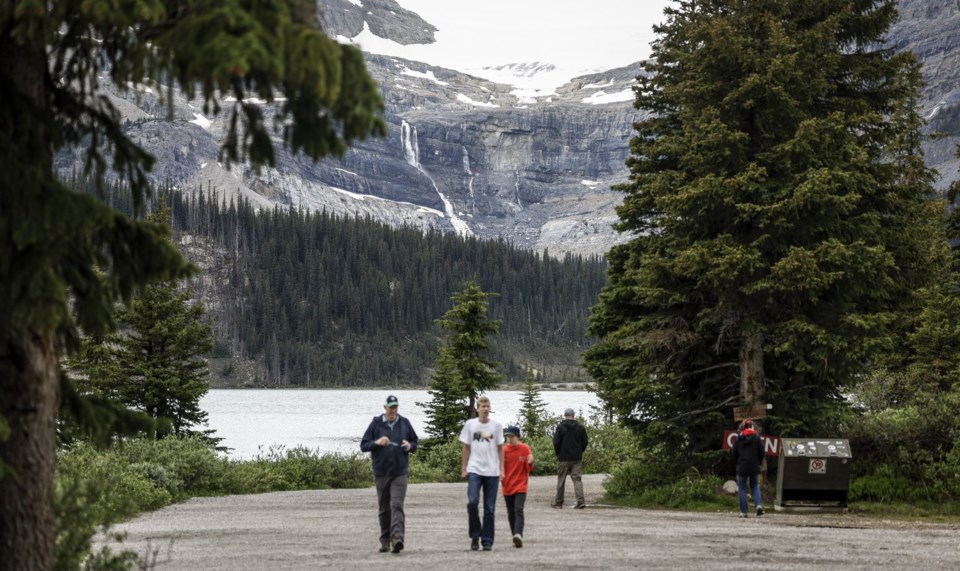Scientist Daniel Shugar says images of the aftermath of Thursday's deadly rockslide in Banff National Park provide evidence of its cause — water flowing through the interior of the mountain.
“You can actually see some springs coming out of the cliff and actually coming out exactly from the scar itself,” said the University of Calgary professor of geomorphology.
He described how water from a lake above the cliff at Bow Glacier Falls had been seeping through rocks for decades before it eventually provided enough force to dislodge a boulder, triggering the rockfall.
“That lake has existed since 1955,” he said. “So over the last 70 years, the water from this lake (and the) glacier retreating has been trying to go downhill through the cracks. It essentially provided the pressure to dislodge the rock.”
While the forces may have been building for years, Shugar and other scientists agree it would have been impossible for Parks Canada to predict or prevent the massive rockfall.
"Yesterday was just a bad confluence of events where this chunk of rock essentially popped out of the cliff," he said. "And, you know, unfortunately, tragically, there were hikers down below.”
Experts agreed that while evidence of previous rockfalls is easy to see, predicting exactly when they will occur is impossible.
Davide Elmo, a mining engineering professor at the University of British Columbia, said that looking at a rock face from the outside doesn't show what's happening inside.
"Some people might ask Parks Canada, why didn't do you anything about it," said Elmo, who also has a degree in engineering geology and is an expert in rock mechanics.
"Well, that kind of rockfall cannot be stopped."
He said the only thing officials can do is to tell the public about the risks when they enter an area that might be prone to rockfalls.
"We know they will happen. We don't know when they will happen," said Elmo.
Witnesses reported rumblings and stones moving before a slab of mountain broke loose and rained boulders on hikers below.
The rockfall occurred in a scenic area close to a popular trail. Looking ahead, Elmo said officials should put up a notice in the area, warning hikers to "minimize the time" spent in that location.
"You can take photos from a distance, but don't stay under the slope. That's the worst place to be," said Elmo.
John J. Clague, an emeritus professor in Earth sciences at Simon Fraser University, said that when he looks at the Banff and Jasper landscapes, he sees lots of cones marking where rockfalls have occurred in the past.
"Predicting exactly where one is going to occur, unless you have some prior indication that something was going on, would be very tough." he said.
Clague said rockfalls are common in the southern Rocky Mountains, but most are never witnessed.
Thursday's slide involved "people being kind of in the wrong place at the wrong time," said Clague.
John Pomeroy, Canada Research Chair in water resources and climate change at the University of Saskatchewan, said there was no early indicator from water levels in Iceberg Lake, which feeds Bow Glacier Falls, that could have predicted the tragedy.
“There’s a lot of randomness and chaos in events like a rock slide, so the conditions were perhaps favourable to it, but that it happened was simply bad luck," he said.
"And particularly happening at that time of day when there were people there was extremely bad luck."
Pomeroy said that this year, the glacier started melting early, raising water levels in Iceberg Lake earlier than normal.
“It’s certainly more hazardous because of climate change, but it’s hard to say that climate change caused any particular event," he said.
Clague said all glaciers in Canada have undergone thinning and retreating amid the warming climate, and he thinks this incident is linked to climate change.
"Because rockfall in that place could not have happened until the face became totally free of ice."
This report by The Canadian Press was first published June. 20, 2025.
Nono Shen, Fakiha Baig and Lisa Johnson, The Canadian Press



